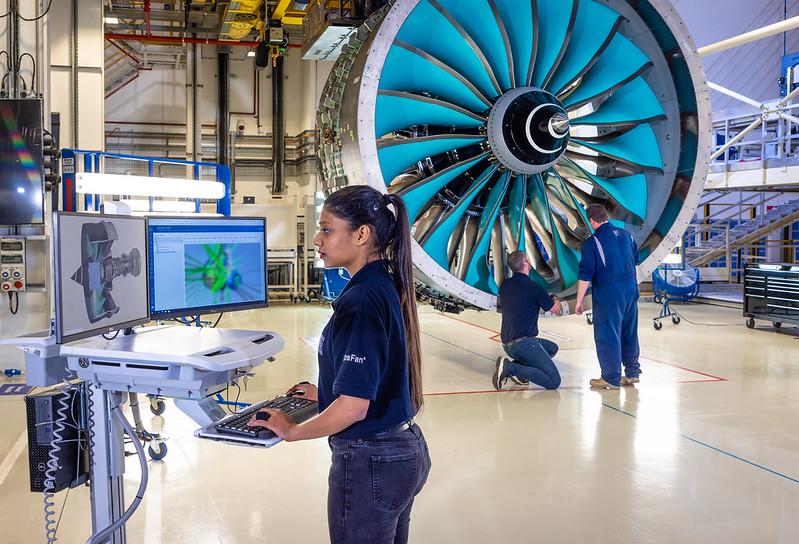
FARNBOROUGH—Eight years after announcing plans to develop the ultra-high bypass, geared UltraFan engine, Rolls-Royce has completed major assembly of the first full-scale demonstrator and is installing final test instrumentation in the run-up to the long-awaited start of ground runs.
With a 14:1 bypass ratio and 140-in.-dia. composite fan, the engine is expected to burn 25% less fuel than the Trent 700—the first member of the Trent family—and forms the basis of what Rolls-Royce hopes will not only be the next generation of turbofans, but a source of technology to upgrade the current Trent 1000 and XWB series.
The engine is also a key element of the company’s long-term drive toward net zero carbon emissions and will be tested using 100% sustainable aviation fuel (SAF). As well as lower fuel burn, the engine is expected to generate 40% less nitrous oxide (NOx), 35% lower noise, and at least 50% less non-volatile particulate matter at airports and almost zero particulate matter at cruise using current fuel.
“This really is a step change on that journey to a lower environmental footprint and to net zero in aviation,” says Andy Geer, chief engineer for the UltraFan Engine Demonstrator Development and Technology program.
Launched in 2014, the demonstrator was sized for a notional 80,000-lb.-plus thrust class requirement for future twins but is designed to prove technology in a gear-driven architecture that is scalable across a 25,000-100,000-lb. thrust range for both single and twin-aisle aircraft. As part of plans to evaluate components at sea level take-off conditions, “we will probably nudge up towards 100,000 lb. towards the end of the test program,” says Geer.
Components for a second demonstrator have also been produced. Rolls originally planned to make four demonstrators but scaled back the effort following the impact of the COVID-19 pandemic, losses incurred through the Trent 1000 corrosion issues, and Boeing’s 2020 decision to shelve its New Midsize Airplane project, which would have been a potential early launch candidate.
Rolls now sees 2030 as the likely timing for service entry, potentially linked to the launch of all-new programs or the possible re-engining of the Airbus A350 or 787 families. The UltraFan will be around 10% more fuel efficient than the Trent XWB.
The near-term focus meanwhile remains on the demonstrator, which will begin runs in the company’s recently completed £90 million ($107 million) Testbed 80 facility in the coming months, Geer says. Instrumentation for more than 2,800 sensors is being installed in the engine, while calibration work is also underway on the testbed in preparation for the test program. This is expected to run well into 2023, but “it’s really open ended because whatever the engine is producing value for us, we’ll continue to test it,” Geer says.
The slowdown in the emergence of all-new aircraft applications has also pivoted the company to a greater emphasis on tests of technology subsets within the UltraFan program for potential retrofits and upgrades.
“Component technology is the easiest to put into an existing architecture so we're probably looking at the hot section—new materials, and manufacturing technologies in the high-pressure turbine,” Geer says. “That's where we'll start, but there are plenty of others that are candidates such as sealing technology, bearing technology, wider application of composites, application of CMC (ceramic matrix composite) technologies—and other things to come, but we’ll start with the hot section.”

